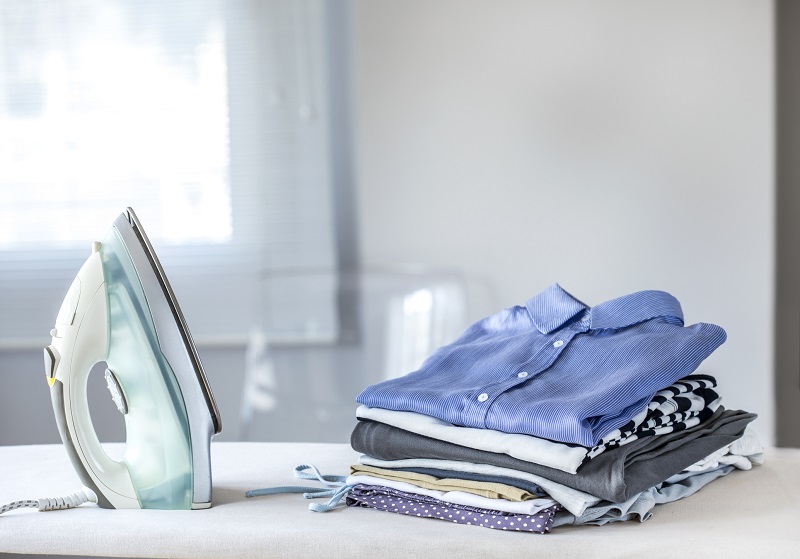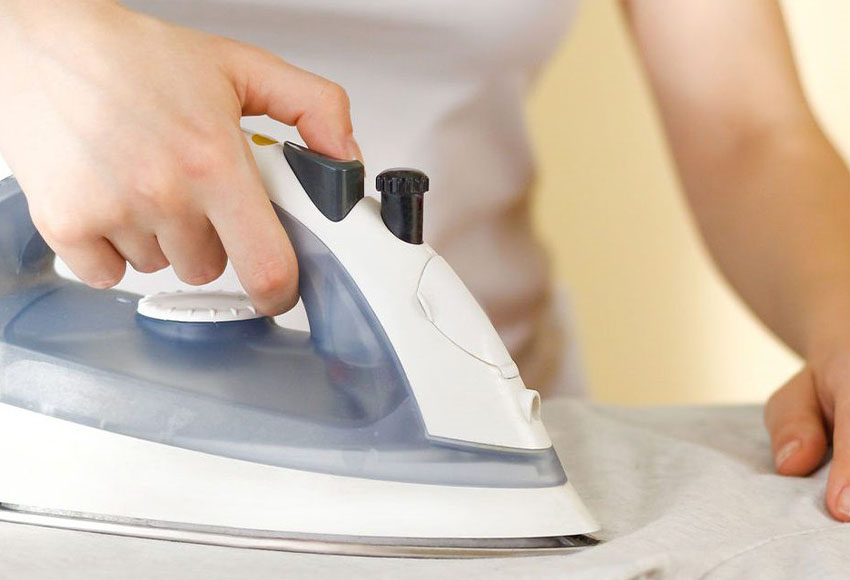Ironing clothes can help prevent moth infestations by exposing them to high heat and physically disrupting moth eggs and larvae. However, it may not completely eliminate moths. To effectively prevent moth damage:
- Clean your clothes regularly.
- Store natural fiber clothing in airtight containers.
- Use moth repellents like cedar blocks or lavender sachets.
- Consider freezing clothing to kill moth larvae and eggs.
- Vacuum closets and storage areas regularly.
How do moths damage clothing?
Moths, particularly clothes moths, are common pests that can cause significant damage to natural fiber clothing, upholstery, and textiles.
Moreover, they are often referred to as “clothing moths” because they are attracted to materials like wool, silk, cotton, and other natural fibers commonly found in clothing. These moths are small, typically about 1/2 to 1 inch in size, and are often a pale, golden color.
Why moths are attracted to natural fibers

Moths are attracted to natural fibers primarily because of the organic materials they contain.
Natural fibers provide moths with a source of sustenance for their larvae, which feed on keratin, a protein found in animal fibers like wool and silk.
Moths are drawn to clothing items that have absorbed sweat, body oils, or other organic substances, as these provide additional nutrients for their larvae.
The scent of these substances can serve as attractants for moths, leading them to lay eggs on susceptible clothing.
Life cycle of moths and their destructive larvae:
The life cycle of a clothes moth typically consists of four stages: egg, larva, pupa, and adult.
Female moths lay tiny, white, oval-shaped eggs on natural fiber materials.
After a period of incubation, the eggs hatch into larvae, which are the destructive stage of the moth’s life cycle. Larvae are tiny, caterpillar-like creatures.
Moth larvae feed voraciously on the fibers of the infested material, causing holes, thinning, and damage to the fabric.
As the larvae grow, they may create silken tunnels or cases as they move around and feed.
Additionally, after a period of feeding and growth, the larvae pupate, forming a cocoon. Inside the cocoon, they undergo metamorphosis and eventually emerge as adult moths.
Adult moths do not feed on clothing; their sole purpose is to reproduce and lay eggs to continue the cycle.
How does ironing prevent moths?
Ironing clothes involves the application of heat and pressure to smooth out wrinkles and refresh fabrics.
As a preventive measure against moths, ironing is effective because it disrupts the moth’s life cycle and eliminates potential attractants.
In addition, ironing can help in preventing moth infestations by addressing both existing eggs or larvae and the conditions that attract moths to your clothing.
The role of heat in killing moth eggs and larvae
Heat is a critical factor in moth prevention, as it can kill moth eggs and larvae.
When you iron your clothes, the high temperature generated can effectively kill moth eggs and larvae that may be present on the fabric.
The heat denatures proteins and enzymes in the eggs and larvae, rendering them unable to develop into destructive pests.
Physical disruption of moth eggs and larvae by ironing
Ironing not only exposes eggs and larvae to heat but also physically disrupts them.
The pressure applied during ironing can crush and damage the delicate eggs and larvae, making it difficult for them to survive.
This physical disruption reduces the chances of eggs hatching and larvae developing into destructive pests.
Removing attractants through ironing
Ironing can also help remove attractants that might lure moths to your clothing.
Moths are attracted to sweat, body oils, and other organic substances found on clothing.
Ironing can effectively remove these substances from the fabric, making your clothes less appealing to moths.
It’s important to focus on areas where these substances accumulate, such as collars, cuffs, and underarms.
What are the limitations of ironing in moth prevention?
While ironing can be a useful preventive measure, it may not be completely foolproof due to several factors. Timing is crucial. Ironing will only be effective if you catch moth eggs or larvae on your clothing before they have caused significant damage.
However, if moths have already laid eggs, and the larvae are deeply embedded in the fabric or have created protective cases, ironing alone may not be sufficient to eliminate them.
Ironing may not reach hidden or hard-to-access areas of your clothing where moths could have laid eggs.
Hidden areas where moths may lay eggs
- Moths are crafty pests and may lay their eggs in concealed or less frequently worn parts of clothing.
- Hidden areas like the folds of garments, seams, and the insides of collars and cuffs are prime locations for moth egg deposition.
- Moths may also lay eggs in stored clothing or in the corners of storage containers or closets, which are difficult to access with an iron.
Deep burrowing of moth larvae into fabric fibers
Moth larvae have a remarkable ability to burrow deep into fabric fibers to find nourishment.
Once inside the fabric, they can create tunnels or cases that protect them from surface treatments like ironing.
Moreover, these protective structures can make it challenging for heat and pressure generated during
ironing to reach and eliminate the larvae effectively.
As a result, even if you iron your clothing, some larvae may survive, continue to feed, and cause damage over time.
How to prevent moths from infesting clothing?

Regular cleaning is one of the most effective ways to prevent moth infestations. It removes moth eggs, larvae, and any organic substances that attract moths.
Wash or dry clean natural fiber clothing items at regular intervals, especially before storing them for an extended period.
Pay attention to items that have been worn and are more likely to have absorbed sweat, oils, or food residues, as these can attract moths.
Proper storage techniques to prevent moth access
Storing your natural fiber clothing properly is essential for moth prevention. Use airtight containers, plastic bags, or garment bags to seal clothing items and prevent moths from accessing them.
In addition, ensure that storage containers are clean and free from any moth eggs or larvae before placing clothing inside.
Use of moth repellents (e.g., cedar blocks, mothballs)
Moth repellents can deter moths from infesting your clothing and storage areas.
Cedar blocks or cedarwood oil emit a scent that repels moths. Place them in drawers, closets, and storage containers.
Mothballs release fumes that are toxic to moths. Use them sparingly and strictly follow safety instructions, as they can be harmful to humans and pets if not used properly.
Freezing clothing as an additional preventive measure
Freezing is a method to kill moth eggs, larvae, and potentially adult moths. Place clothing items in a sealed plastic bag and freeze them for several days at a temperature below 0°F (-18°C). This process can destroy any existing moth life stages, rendering them nonviable.
Vacuuming closets and storage areas
Regular vacuuming of closets, drawers, and storage areas helps remove moth eggs, larvae, and any debris that may attract moths.
Moreover, pay particular attention to corners, crevices, and shelving where moths may hide.
Empty the vacuum cleaner bag or container outside to prevent any trapped moths from re-infesting your space.
FAQ’s
Does ironing kill moth eggs on clothes?
Ironing can kill some moth eggs on clothes due to the heat, but it may not eliminate all of them, especially if they are deeply embedded.
How do you permanently kill moths?
To permanently eliminate moths, a combination of strategies is needed, including regular cleaning, proper storage, using moth repellents, and freezing clothing to address all life stages.
Will drying clothes kill moths?
Drying clothes at high temperatures can kill moths and their eggs. It’s an effective preventive measure, especially for infested items.
What heat kills moth eggs?
Moth eggs are generally killed at temperatures above 120°F (49°C). This temperature is necessary to ensure their complete destruction.
How long can clothes moth eggs survive?
Clothes moth eggs can survive for up to two weeks before hatching, depending on environmental conditions like temperature and humidity.
How long do clothes moths last?
The adult clothes moth’s lifespan is relatively short, typically ranging from 1 to 4 weeks, during which they lay eggs on susceptible materials.
Final Words
In conclusion, when it comes to dealing with moths and protecting your clothes, it’s important to use a variety of strategies. Just ironing your clothes won’t do the trick by itself. Instead, think about regularly cleaning your natural fiber clothes, storing them properly, and using moth repellents like cedar blocks or mothballs.
Furthermore, freezing your clothes can help too, and don’t forget to vacuum your closets and storage areas. Combining these methods gives you a much better chance of keeping those pesky moths away and your clothes safe and sound.

